Human powered flight (in English) 
This page was last updated: 5 Aug 2001
Fliegen wie ein Mensch (in Deutsch) 
 Description
Description
Specification
FAQ's
Next flights 1999
Human Power Festival in Interlaken Switzerland
1999
References
High Altitude Long Endurance Aircraft
events 2000
events 2001
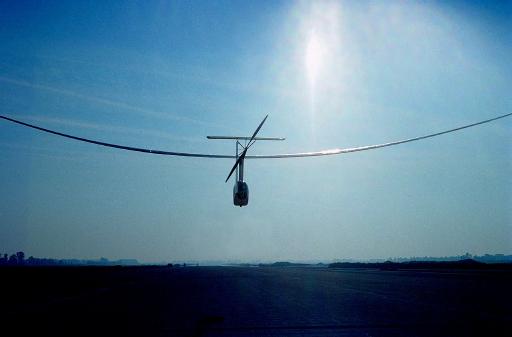 Vélair 89 was the first aircraft to fly "from" Munich airport (MUC) runway in the summer of 1990
Vélair 89 was the first aircraft to fly "from" Munich airport (MUC) runway in the summer of 1990
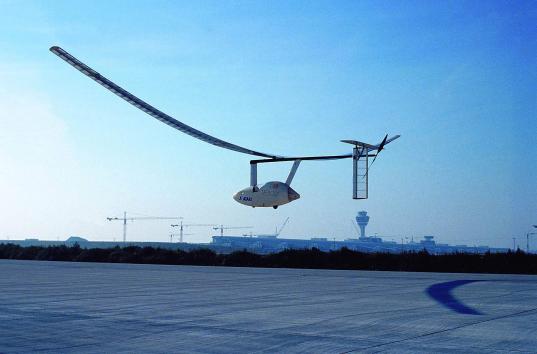
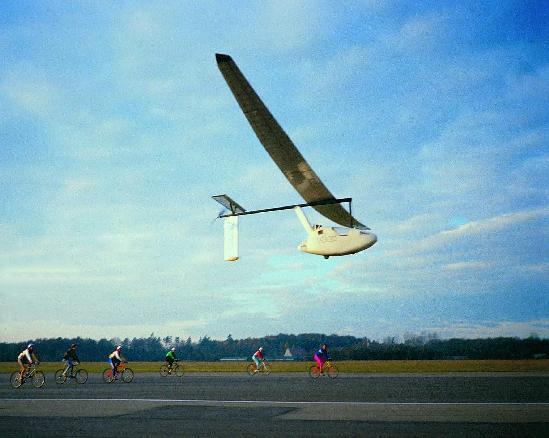 This was Vélair 88 during a flight in Malmsheim
near Stuttgart. Notice the old (stiffer) wing and rudder, and the video
camera on top of the fuselage.
This was Vélair 88 during a flight in Malmsheim
near Stuttgart. Notice the old (stiffer) wing and rudder, and the video
camera on top of the fuselage.
This aircraft is designed for minimum required power to allow
for some endurance. It's size is quite small resulting in a relatively
"high" flight speed. For that reason its wing is cantilevered (no wires
or struts) because their drag would not be compensated by the lower weight.
The power required with a 60 kg pilot is about 225 Watt. It is capable
of normal take off and landing on a hard runway.
Vélair was built in the original version
'88' and improved during the following year, the "89" version, mainly with
a new wing (larger, higher aspect ratio, lighter, thinner, nicer, cheaper,
lower drag... :-))
| Version |
Vélair 88 |
Vélair 89 |
| first flight |
9 August 1988 |
24 September 1989 |
|
its wing was later recycled for the Icaré 1
solar powered aircraft of Stuttgart University |
|
| Features |
|
|
wing platform
number of segments |
double trapeze
3 pieces
cantilever |
rectangle/trapeze
5 pieces
cantilever |
| seat position |
recumbent 40 ° |
" |
| controls |
3-function cardan sidestick (on the RH side) |
" |
| roll control (electric) |
aileron |
rotating wing tip |
| yaw control |
push rods & cable, all flying rudder |
" |
| pitch control |
push rods & cable with "bungee" trim, all flying elevator |
" |
| Geometry |
|
|
| Wing span |
71.2 ft (21.7 m) |
76.1 (23.2 m) |
| Wing area |
176.5 sqft (16.4 m²) |
183 sqft (17 m²) |
| Aspect ratio |
27 |
31.7 |
| Weights |
|
|
| Empty weight |
83.6 lbs (37.9 kg) |
67.2 lbs (30.5 kg) |
| Max take off weight |
220 lbs (100 kg) |
220 lbs (100 kg) |
| Power loading |
|
396 kg/kW (!!!) |
| Wing loading |
|
25.9 lbs/sqft (5.3 kg/m² ) |
| Wing weight |
52.5 lbs (23.8 kg ) |
36.8 lbs (16.7 kg ) |
| Propulsion |
|
|
prop diameter
prop speed
number of blades |
8.9 ft (2.70 m)
190 rpm
2 blades
carbon shell with web
ground adjustable pitch |
" |
| power transmission |
twisted chain +
carbon driveshaft |
" |
| Construction |
|
|
| Fuselage |
carbon sandwich space frame with Polystyrol/GFRP sandwich fairing |
|
| wing spar |
I-beam spar: CFRP (T300/HYE 1048) caps, GFRP/Rohacell sandwich web |
tailored CFRP (T800/M10) tube spar |
| wing shell |
GFRP/Polystyrol sandwich |
Polystyrol |
| wing ribs |
Styrodur with carbon caps |
Styrofoam with balsa caps |
| wing cover |
- |
Hostaphan |
| wing airfoil (thickness) |
FX 63-137 (13.7%) |
PF 25 (12.9%) |
| ultimate load factor |
3.0 g |
3.36 g (ultimate load, tested) |
| Speeds |
|
|
| design speed |
|
17 KEAS (31 km/h, 8.6 m/s) |
| stall speed |
|
15 KEAS (27 km/h; 7.5 m/s) |
| max horizontal speed (power limited 0.4 HP) |
|
22 KEAS (41 km/h; 11.4 m/s) |
| never exceed speed (torsional divergence limited) |
|
27 KEAS (51 km/h; 14.2 m/s) |
| Performance |
|
|
| design power |
|
3.75 Watt/kg pilot weight) (225 W) @ 90kg gross weight) |
| Take off distance (198 lbs/90kg, ISA, no wind) |
|
~260 ft (~80 m) |
| Rate of climb @ 0.4 HP (300 W) climb power |
|
20 ft/min (0.1 m/s) well... |
Thanks to the team
There was a lot of help from many friends. Special thanks
to those who went all the way through: Ben Russ, Martin Hübner, Jochen
Hanne who spent so many nights and weekends in the workshop, their contribution
is invaluable.
Thanks to our sponsors
Many companies and institutions contributed to the project:
Atari with a great computer and OS, in alliance
with Frank Ostrowski's GFA, this combination was an extremely powerfull
tool. It allowed fast, efficient and fuzz free software development to
answer those many design and performance questions (which became the core
of a complete aircraft design and performance package).
Also thanks to F.J.Arendts, R.Eppler and E. Messerschmid
from University of Stuttgart for their logistic (workshop), scientific
and morale support.
Also biggest gratitude to the industry for giving this
and that:
Bakelite (resins), Beiersdorf (adhesive
films), Blaschke Aeolite pedals, Daimler Benz (fuselage 3-D
panel calculations, test field), Eurocomposites (honeycombs), Fiberite
(carbon prepregs),
Gaugler & Lutz (Airex thermoplast foam),
Kalle/Höchst
(Hostafan film), INA Schäffler (metallic bearings), Grünzweig
& Hartmann (Styrodur foam), MBB / Donauwörth (autoclave
run), Mutliplex (aileron control servos),
Röhm (Rohacell),
Velotraum
(cycling shoes), Brodbeck (seal tape), DLR (water jet cutting
machine), Roland Schirrmacher (prop mold), Martin Siegwarth & Thorn
Richter (flight data aquisition system & sensors), MBB Manching, airport
München, aeroport de Paris (runways), Polaroid (ultrasonic
altimeter), university of Stuttgart (workshop, metallic parts).
-
do I have to be a bicycle champion to fly this aircraft ?
-
This depends on the individual's shape and weight. The power
required to "cruise" is about 3.75 Watt/kg body weight which can be sustained
for 1...2 hours by a well trained athlete. Try yourself on an ergometer
to find out. Typical heart rate is about 160 /minute which is not exactly
relaxing, but still bears some margin to the red line.
-
what is the power required ?
-
With 90 kg gross weight about 225 Watt are required for unaccelerated
horizontal flight (this includes transmission losses and propeller efficiency).
Would this power be provided by a combustion engine this would correspond
to a fuel consumption of 0.24 liter/100km (this is a milage of 848 mpg)
!!!
-
what is it made of ?
-
The primary structure is made of carbon fiber reinforced
epoxy, with custom fabricated and tailored tubes with or without a sandwich
core. Those prepreged materials have to be cooked with pressure and
temperature. The secondary structure is made of all kinds of foams, wood,
and
a very light cover film (Hostaphan). Genious fabrication methods were developed
to enable production and make it robust.
-
how fast does it fly ?
-
The speed range is between 27 and 45 km/h (14...25 KEAS)
with minimum power required speed at 31 km/h (17 KEAS)
-
where can I buy one ?
-
Nowhere. If you make a good offer I'll build you your own
one ! (and they get better each time)
-
what about wind ?
-
No problem as long as it is smooth and directed right on
to the nose. 12 knots have been demonstrated on the Paris Air Show. But
cross wind is a show stopper.
-
how does it fly ?
-
Well, not too bad. Pitch response is sensitive, rudder authority
is OK, and roll control is kind of slow, specially during take off. In
flight it is fully stable and does not need input when correctly trimmed
and if there is no turbulence. Turns are induced with rudder and aileron, but then cross
aileron (against turning direction) is required soon to support the
inner wing. Throttle response and spool up is pretty fast but excess power is lowsy.
-
Why is the wing so flexible ?
-
There is no gramm of material wasted, it is just stiff enough
to support the fuselage and stay in an efficient shape. As a cantilever
wing with such a high aspect ratio the structural design driver is stiffness
rather than strength. That's why the safety margin to ultimate load is ample.
-
how long does it take for take off ?
-
With no wind ca. 80 m (260 ft). The nose wheel can be rotated off
quite soon so that the take off run is on the main wheel only. High concentration
is required to keep the wings level with bad low speed roll control authority.
Of course MTO power is applied until a slight rotation of a few degrees
lifts us off. As soon as cruise altitude is reached power can be reduced.
-
How is the aircraft transported ?
-
We modified an old sailplane trailor to accomodate the large
dimensions, specially the high fuselage. The largest wing segment is 7.50
m long.
-
What for is this aircraft anyway ?
-
imagine you ride your bike at 30 km/h, then slightly pull
on the sidestick and rotate to continue to ride in a couple of meter above
ground level. Now after a slight turn you float over the meadows, jump
over a small fence, cross that creek... Isn't that a reason ?
-
To make fly a human body on his own low-sy power is quite
a challenge. Challenges must be addressed.
-
How to configure, design and make such an aircraft resulted
in plenty of valuable lessons learned about configuration, layout, detail
design, aerodynamics, performance, stability and control, aeroelasticity,
fabrication techniques, light weight materials... that are applicable to
other high performance aircraft, specially for the cases where propulsion
power is strongly limited like for high altitude aircraft that are designed
to fly in the stratosphere, or for aircraft with very low fuel consumption and long endurance.
-
What is GFRP and CFRP ?
-
glass and carbon fiber reinforced plastic, using epoxy resins
as a matrix. Aramid fibers have been used as well. Hand laminating of fabrics
as well as prepreg curing of UD-layers as been applied. Intermediate modulus
carbon fibers and a low pressure low temp cure resin prepreg were used
for the Vélair89 spar.
If I don't brake it during training and checkflights, if
weather is benign, and if traffic authorities clear my prehistoric trailor
(TÜV), the next public flights are scheduled for the Human
Power Festival in Interlaken Switzerland 14... 22 August 1999.
It will be a big suspense because the last flights were
performed a long time ago. The aircraft and the pilot are 10 years older
now what certainly does not contribute to the performance of both. The
aircraft got some more dents, not only from a few landings in the potato
fields but also from so many expositions, the cover got many ribbles, and
our cats loved it as a tree substitute while it was stored in our
living room. Fortunately there is extra wide "TESA" (sticky tape) to quickly
fix but clearly at the expense of aesthetics. It really has to be considered
as a vintage plane now. And the pilot is now carrying an extra 10 kg of
"reserve fuel" (fat).
We will see...
...We saw: in spite of its design life of one summer Vélair
still flies (and is still in one piece !).
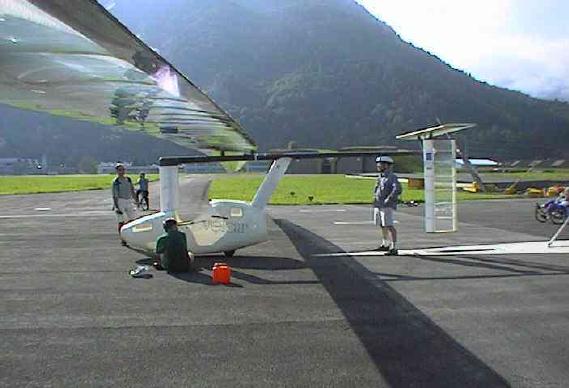
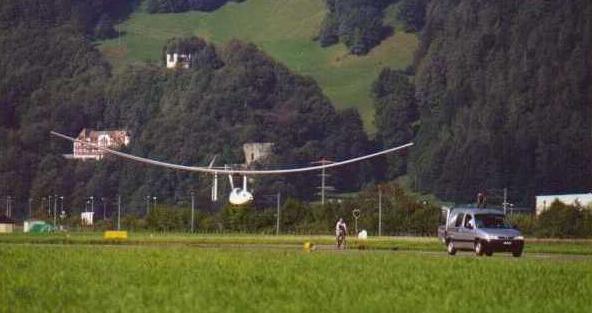
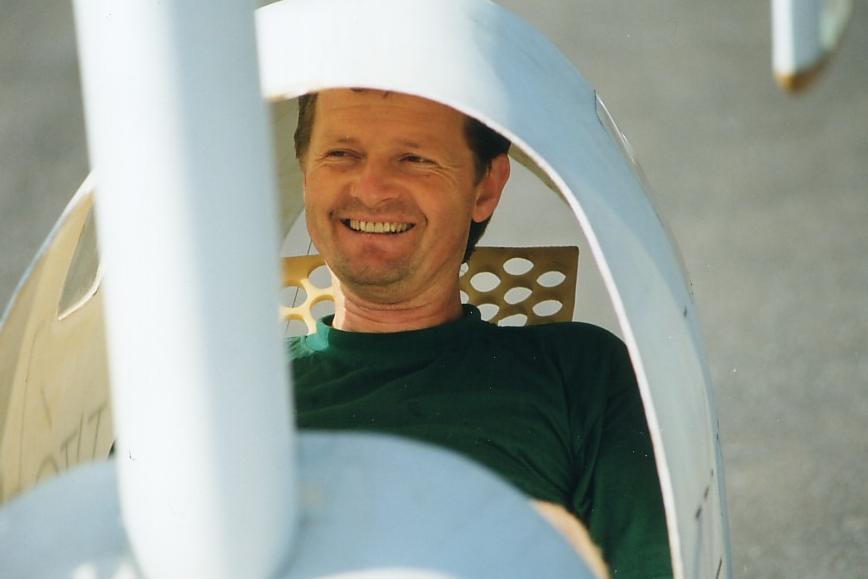
At the Interlaken Human Power Festival August 1999.
-
26 January: presentation to VDI-Verein Ulm: "Fliegen wie
ein Mensch"
-
16 March: presentation to SAMPE (Society for the advancement
of materials and process engineering) /University of Stuttgart: "Fliegen
wie ein Mensch"
-
Vélair on Discovery Channel: "Extreme maschines"
(Pioneer Productions)
-
Vélair at ARD Tigerentenclub:
May (including some short snapshots about Pelargos 3 and the very
first flight
Vélair 88)
-
Spokes Festival
in Leicester /UK: 28...31 July (Airglow
HPA will be on display)
-
Fahrradausstellung in Nürnberg Fall 2000 (perhaps with
flight demo). Whether flights will be possible depends on time on hand
for the preparation, same procedure as last year. This will be posted here
in time.
12 August: Sorry, no demo
flights in Nürnberg, there will be no event on an airfield.
Demo flights can be booked now. Minimum requirement is a
hard 700 x 10 m runway. The longer the better. Flights scheduled to start
in June 2001.
-
Fliegen mit 225 Watt. Muskelkraftflugzeuge und Anwendungen.
Deutsche Gesellschaft für Luft und Raumfahrttechnik, Oktober 1990,
Bonn.
-
Human powered aircraft, the limits of light weight construction:
OSTIV symposium Wiener Neustadt 1989.
-
The human powered aircraft Vélair: design details
and result of structural, prop and flight tests. AIAA International human
powered flight symposium August 1994, Seattle Washington, USA.
-
Human powered flight as a sport. Symposium at the Royal Aeronautical
Society January 1996.
-
Design of aircraft with minimum required power. Stuttgart
1990.
-
Technological spin off from human powered to high altitude
long endurance aircraft. The Royal Aeronautical Society, London January
1999.
From other autors:
-
Keith Sherwin: Man powered flight. Model & Allied publications
Argus Books ltd, Kings Langley UK, 1971.
-
Morton Grosser: The gossamer Odyssey. Houghton Mifflin Company,
Boston USA, 1981.
-
Gary Dorsey: The Fullness of Wings . Viking Pinguin, New York
USA, 1990.
My flight experience with HPA's:
(nono, I crashed only very few of them !)
| Aircraft |
built by |
country |
configuration (all conventional tail) |
year |
| Pelargos II |
Max Horlacher |
CH |
27m, multiwire rectangular higfh wing, tractor prop |
1983 |
| Pelargos III |
Max Horlacher |
CH |
22m, singlewire and strut rectangular wing, tractor prop |
1985 |
| Musculair 2 |
GünterRochelt |
D |
19.5m cantilever trapeze wing, pusher prop |
1985...1986 |
| Vélair 88 |
Peer Frank |
D |
21.7m cantilever double trapeze wing, pusher prop |
1988-89 |
| Vélair 89 |
Peer Frank |
D |
23.2m cantilever rectangular/trapeze wing, pusher prop |
since 1989 |
| Airglow |
John McIntyre |
UK |
25m single wire trapeze wing, pusher concentric prop |
1992 |
For more information about human powered vehicles (land/water/air/rail)
see:
International Human Powered Vehicle
Association
HPV Deutschland, der Club f�r innovative Fortbewegung

home
![]()
 Vélair 89 was the first aircraft to fly "from" Munich airport (MUC) runway in the summer of 1990
Vélair 89 was the first aircraft to fly "from" Munich airport (MUC) runway in the summer of 1990

 This was Vélair 88 during a flight in Malmsheim
near Stuttgart. Notice the old (stiffer) wing and rudder, and the video
camera on top of the fuselage.
This was Vélair 88 during a flight in Malmsheim
near Stuttgart. Notice the old (stiffer) wing and rudder, and the video
camera on top of the fuselage.


